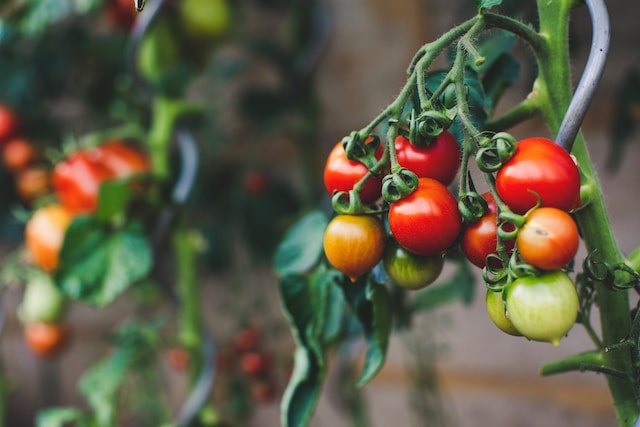Your Cart is Empty
Add description, images, menus and links to your mega menu
A column with no settings can be used as a spacer
Link to your collections, sales and even external links
Add up to five columns
Add description, images, menus and links to your mega menu
A column with no settings can be used as a spacer
Link to your collections, sales and even external links
Add up to five columns

Growing Your Best Tomatoes Yet: Fertilizers
April 26, 2023 4 min read
Tomatoes are heavy feeders, so they will benefit from regular fertilizing. In this article, we'll discuss the elements to look for in fertilizers to ensure you are giving your tomatoes what they need!

Fertilizer numbers
The numbers on fertilizers refer to the percentage by weight of the three primary macronutrients that are present in the fertilizer: nitrogen, phosphorus, and potassium. These three nutrients are often abbreviated as N-P-K.
For example, if a fertilizer has the numbers 10-10-10 on its packaging, it means that the fertilizer contains 10% nitrogen, 10% phosphorus, and 10% potassium by weight.
The first number represents the percentage of nitrogen in the fertilizer. Nitrogen is essential for plant growth and is responsible for promoting healthy foliage growth.
The second number represents the percentage of phosphorus in the fertilizer. Phosphorus is necessary for flower and fruit development, root growth, and overall plant health.
The third number represents the percentage of potassium in the fertilizer. Potassium is important for regulating water balance in the plant, improving disease resistance, and enhancing fruit quality.

Nitrogen (N)
Nitrogen is a crucial element in plant growth and development. It is responsible for the green color of leaves and stems and helps plants grow quickly. Nitrogen promotes the growth of foliage and can help your tomato plants produce more leaves, which can lead to increased photosynthesis and higher yields.
However, too much nitrogen can result in excessive leaf growth at the expense of fruit production. Too much nitrogen can also lead to weak stems that are more susceptible to damage from wind or heavy fruit.

Phosphorus (P)
Phosphorus plays an essential role in root development, flower formation, and fruit production. Phosphorus helps your tomato plants develop strong root systems, which can improve nutrient uptake and water absorption. It also helps your plants produce more flowers, which can lead to more fruits. Too much however, can increase the risk of root rot, as excessive phosphorus can promote the growth of harmful fungi in the soil.

Potassium (K)
Potassium is needed to aid in fruit development and disease resistance. Tomato plants can benefit from the strengthening of their cell walls with potassium, leading to an enhancement in the quality of their fruit and a decrease in susceptibility to diseases. It also helps your plants regulate water uptake and retention, which can improve drought tolerance.
As a general rule of thumb, when looking at NPK ratios for tomato plants you want the second number, phosphorous, to be about twice the first number, nitrogen. The higher phosphorus content in these fertilizers helps promote healthy root and flower development, while the potassium aids in overall plant growth and fruit development.
However, it’s important to note that there is no one-size-fits-all fertilizer solution for all tomato plants. Each tomato plant has its own unique needs based on factors such as soil type, climate, and plant variety. Moreover, different stages of tomato growth require different levels of nutrients.

Micronutrients:
Calcium (Ca)
Calcium is important for maintaining cell wall structure and rigidity, and it also helps with the uptake and transport of other nutrients within the plant. A deficiency in calcium can result in blossom end rot, a common problem in tomato plants where the bottom of the fruit develops a brown, sunken area. To prevent blossom end rot and ensure proper growth, it is important to provide adequate amounts of calcium in the fertilizer.
Although, once a plant has been affected by blossom end rot, it’s best to throw them away since they’re not salvageable and the brown, sunken area will not go away.

Magnesium (Mg)
Magnesium is necessary for the production of chlorophyll, which aside from being essential in photosynthesis, is what gives plants their green color. If you’re noticing yellowing of the leaves, stunted growth, and decreased fruit production in tomato plants, it’s best to supplement with magnesium. Providing magnesium in the fertilizer can help prevent these problems and promote healthy growth and development.

Trace nutrients
Trace nutrients are essential elements that plants require in small amounts. They include elements such as iron, zinc, copper, and manganese, among others. These elements play important roles in enzyme function, photosynthesis, and other metabolic processes within the plant. Deficiencies in these trace nutrients can cause a variety of problems, such as leaf discoloration, stunted growth, and reduced yields. The addition of trace nutrients to the fertilizer can aid in getting rid of these issues and facilitate prompt growth and development of the plants.

In conclusion, providing your tomato plants with the appropriate nutrients is critical for achieving healthy growth and an abundant harvest. In addition to the primary elements of nitrogen, phosphorus, and potassium, calcium, magnesium, and trace nutrients are also essential for optimal plant growth and development. By using high-quality fertilizers that contain the right balance of these essential elements, you can ensure that your tomato plants have the nutrients they need to thrive. Remember to carefully follow the instructions on the fertilizer package and adjust the application rates based on your plant's specific requirements to achieve the best results.
Subscribe
Sign up to get the latest on sales, new releases and more …
